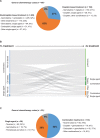Real-World Effectiveness of Chemotherapy in Elderly Patients With Metastatic Bladder Cancer in the United States
- PMID: 29732393
- PMCID: PMC5929305
- DOI: 10.3233/BLC-170149
Real-World Effectiveness of Chemotherapy in Elderly Patients With Metastatic Bladder Cancer in the United States
Abstract
Background: Outcomes for patients with metastatic bladder cancer (mBC) are generally poor and progressively worse following first-line (1L) chemotherapy.
Objective: To evaluate treatment patterns, survival outcomes, and characteristics of a large, real-world US population of elderly patients with advanced mBC receiving 1L and second-line (2L) treatment retrospectively.
Methods: We identified patients with advanced mBC (aged ≥66 years)-newly diagnosed between January 1, 2004, and December 31, 2011-in the National Cancer Institute Surveillance, Epidemiology, and End Results (SEER) Program-Medicare linked database and assessed their palliative systemic chemotherapy treatments and survival outcomes.
Results: Of 1703 eligible patients, 42% received 1L chemotherapy; 1L-treated patients tended to be younger and healthier than nontreated patients. Only 27% of 1L-treated patients received cisplatin-based chemotherapy, most commonly cisplatin-gemcitabine. Cisplatin-treated patients were younger and had fewer comorbidities than non-cisplatin-treated patients. Thirty-five percent of 1L-treated patients subsequently received 2L chemotherapy. Patients received a variety of 2L agents as combination chemotherapy (52%) or single-agent chemotherapy (39%). Median overall survival durations in 1L-treated and 2L-treated patients were 8.5 and 7.9 months, respectively.
Conclusions: Results from this retrospective SEER-Medicare database analysis underscore the historical inadequacies of 1L and 2L treatments in elderly patients with advanced mBC. Few patients were treated with 1L chemotherapy, a minority of whom received 1L cisplatin-based chemotherapy, and even fewer received 2L chemotherapy. These findings highlight the disconnect between 1L treatment in clinical trials and treatment in the real-world setting and the lack of standard approaches to 2L treatment in the United States.
Keywords: Aged; delivery of health care; drug therapy; urinary bladder neoplasms.
Figures


Comment in
-
Re: Real-World Effectiveness of Chemotherapy in Elderly Patients with Metastatic Bladder Cancer in the United States.J Urol. 2019 Jun;201(6):1033-1034. doi: 10.1097/01.JU.0000554635.81490.8f. J Urol. 2019. PMID: 30864905 No abstract available.
References
-
- National Comprehensive Cancer Network. NCCN Clinical Practice Guidelines in Oncology: Bladder cancer. V5.2017. 2017; cited 2017 Sep 7]. Available from: https://www.nccn.org/professionals/physician_gls/pdf/bladder.pdf.
-
- National Cancer Institute. SEER Cancer Stat Fact Sheets: Bladder cancer. 2017 [updated 2017; cited 2017 Sep 7]. Available from: https://seer.cancer.gov/statfacts/html/urinb.html.
-
- National Cancer Institute. SEER Cancer Statistics Review, 1975-2012. [2015; cited 2017 Sep 7]. Available from: https://seer.cancer.gov/csr/19752012/.
-
- Loehrer PJ Sr, Einhorn LH, Elson PJ, Crawford ED, Kuebler P, Tannock I, et al. A randomized comparison of cisplatin alone or in combination with methotrexate, vinblastine, and doxorubicin in patients with metastatic urothelial carcinoma: A cooperative group study. J Clin Oncol. 1992;10(7):1066–73. - PubMed
-
- von der Maase H, Sengelov L, Roberts JT, Ricci S, Dogliotti L, Oliver T, et al. Long-term survival results of a randomized trial comparing gemcitabine plus cisplatin, with methotrexate, vinblastine, doxorubicin, plus cisplatin in patients with bladder cancer. J Clin Oncol. 2005;23(21):4602–8. - PubMed
Grants and funding
LinkOut - more resources
Full Text Sources
Other Literature Sources

